This post may contain affiliate links, which means I'll earn a small commission if you purchase something through these links. You won't pay any extra; instead, you'll be helping Aloha With Love to thrive. Thank you! Learn more.
--
Dad has been into Korean dramas for the past few years and he’s catching on to the yummy food they eat in the shows! Budae jjigae is one recipe that has his attention!
Budae jjigae is army base stew – a fusion of Korean and American cuisines with a unique history. The addition of U.S. army foods into a traditional Korean stew has a loyal fanbase and we particularly enjoy it in Hawaii since we love our SPAM! There are several variations of budae jjigae, but this is the recipe that we usually stick with. Watercress is not something I’ve really seen in other budae jjigae, but here in Hawaii it’s really cheap and easy to get. Plus, the refreshing bite from watercress matches really well with the kimchee flavor.
Aloha with love,
Amy
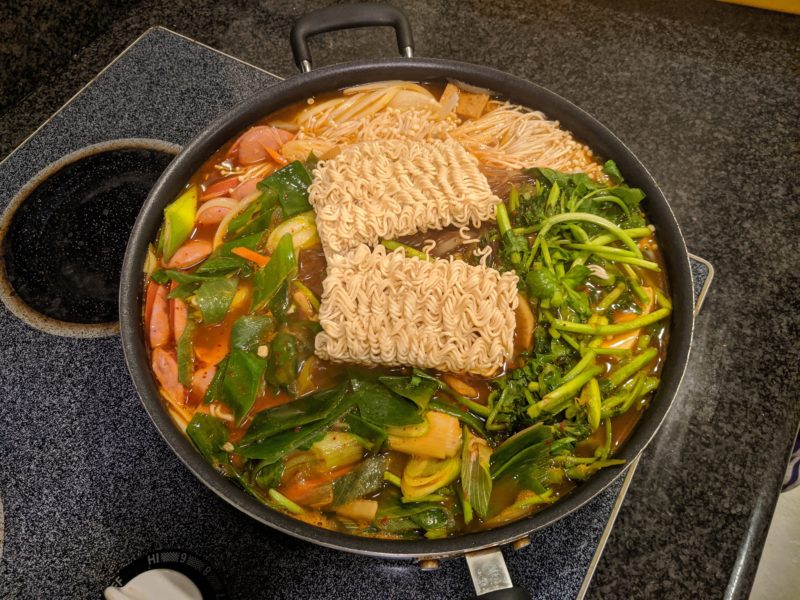
Ingredients
- Pork Mom prefers pork butt or pork belly.
- Japchae noodles Korean glass noodles.
- Watercress
- Firm tofu
- Deep-fried tofu
- Portugese sausage
- Spam
- Green onions
- Enoki mushrooms
- Very fermented kimchee
- Onions
- Ddukbokki
- Dehydrated ramen noodles
Soup base
- 32 oz chicken stock
- 2 c water
Spicy paste mix
- 1 tbsp brown sugar
- 2 tbsp gochujang
- 2 tbsp Korean chili pepper flakes Gochugaru.
- 1 tbsp shoyu
- 3 cloves chopped garlic
Instructions
- Cut the pork into large chunks. Heat up the water on the stove and add the pork. When the pork is cooked on the outside, remove the pork and pour out the water and scum.
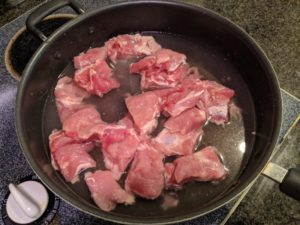
- Soak japchae noodles in a bowl of water for about 15 minutes to soften. Cut in half. Leave in the bowl of water as you get the other ingredients ready.
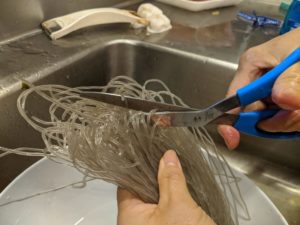
- Cut all other ingredients into bite-sized chunks for easy scooping. Feel free to add different ingredients to your stew or take some out. Some other ingredients that we have included in the past are fish cake, cabbage, konnyaku, daikon, vienna sausage, eggs, aburaage, etc. The larger the variety, the more fun everyone has while eating it.The only mandatory ingredient is the very fermented kimchee since the sour cabbage and kimchee flavor really makes this dish shine.

- In a small bowl, mix together brown sugar, gochujang, Korean chili pepper flakes, shoyu, and chopped garlic in a small bowl. This is the spicy paste that will flavor the soup and ingredients.
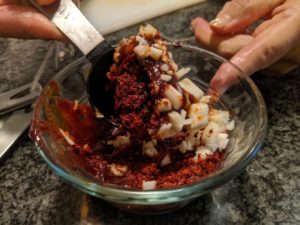
- Set a large pot on the stove and adjust the temperature to high heat. Add in the chicken stock and water. For the first layer of items, add everything that will take longer to cook or heat up. In Mom's version, she added the onions, deep-fried tofu, ddukbokki, firm tofu, spam, and Portugese sausage. In the middle of this first layer, put in the very fermented kimchee and the spicy paste.Note: Besides soaking up the flavor, these ingredients won't change their shape too much while being cooked.
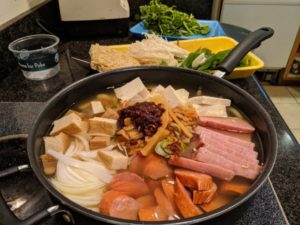
- Once the first layer has been set up, work on the second layer, which should be all other ingredients (except for the dehydrated ramen). For this version we added the green onions, watercress, japchae noodles, and mushrooms because they cook quickly.Note: The green onions and watercress especially needs to be on the top because they take up a lot of space when raw. As the steam cooks them, they will soften and take up less space.
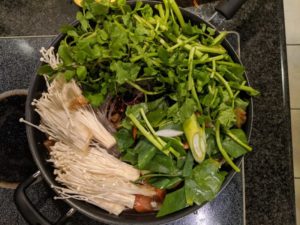
- Let the stew come to a boil. Push the ingredients down into the water so that everything cooks and absorbs the kimchee and spicy flavor. The soup will turn a nice red as it heats up. When the soup reaches a boil and everything has cooked, turn the stove off, add the dehydrated ramen and cover for a few minutes. Place the pot in the middle of the table where everyone can reach and dig in.
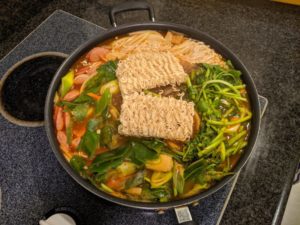
Notes
- This recipe is very forgiving. Put as much or as little of whatever ingredient you’d like to eat.
- The older the kimchee, the better. Older kimchee does well in soups and stews as the strong, pungent flavor spreads out nicely.
- The bottom layer are all items that need a longer time to cook/heat up. The top layer of ingredients cook very quickly in comparison.
